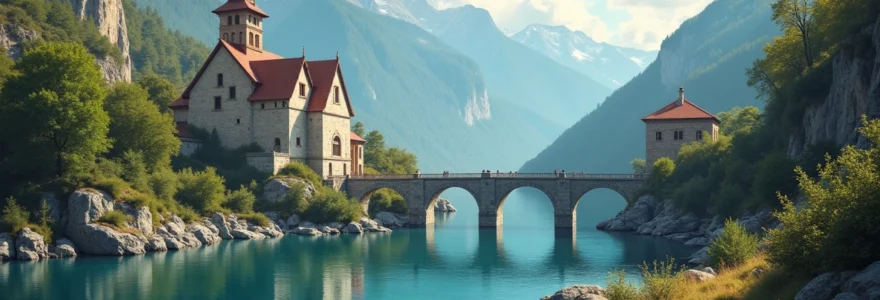The Balkan Peninsula, a captivating mosaic of diverse cultures, rich history, and breathtaking landscapes, has long fascinated travellers and scholars alike. Stretching from the Adriatic Sea to the Black Sea, this southeastern European region encompasses a tapestry of nations, each with its own unique identity and story. From ancient civilisations to modern-day geopolitics, the Balkans offer an unparalleled journey through time, language, and tradition.
Historical tapestry of the balkan peninsula
The Balkans have been a crucible of civilisations for millennia, with each era leaving an indelible mark on the region’s culture and landscape. This rich historical tapestry is woven with threads of conquest, cultural exchange, and resilience, creating a complex and fascinating narrative that continues to shape the region today.
Ancient illyrian and thracian civilisations
Long before the rise of more familiar empires, the Balkans were home to sophisticated indigenous cultures. The Illyrians, inhabiting the western Balkans, and the Thracians, dominating the east, left behind a legacy of art, metallurgy, and mythology that still echoes in modern Balkan cultures. These ancient peoples laid the foundation for the region’s unique cultural identity, blending local traditions with influences from Greek and Roman civilisations.
Byzantine empire’s influence on balkan culture
The Byzantine Empire, centred in Constantinople (modern-day Istanbul), exerted a profound influence on the Balkans for over a millennium. This Eastern Roman Empire brought Christianity, advanced architecture, and a sophisticated administrative system to the region. The Byzantine legacy is particularly evident in the Orthodox Christian traditions, iconic religious art, and the enduring influence of Greek culture throughout the Balkans.
Ottoman conquest and 500-year rule
The Ottoman Empire’s expansion into the Balkans in the 14th century marked a pivotal shift in the region’s history. For nearly 500 years, Ottoman rule shaped the cultural, religious, and architectural landscape of the Balkans. This period introduced Islam to the region, left behind magnificent mosques and bridges, and influenced everything from cuisine to language. The Ottoman legacy remains a complex and sometimes contentious part of Balkan identity.
Yugoslav wars and Post-Soviet era transitions
The late 20th century brought dramatic changes to the Balkans. The collapse of Yugoslavia led to a series of devastating conflicts, reshaping borders and societies. In the aftermath, new nations emerged, each grappling with the challenges of post-communist transition and the quest for European integration. This recent history has left deep scars but also fostered resilience and a renewed sense of national identity across the region.
Diverse ethnolinguistic landscape
The Balkans boast an incredibly diverse linguistic landscape, reflecting the region’s complex history and cultural interactions. This diversity is not just a matter of academic interest; it’s a living, breathing part of daily life in the Balkans, shaping identities, relationships, and even political dynamics.
Slavic languages: serbian, croatian, and bulgarian
Slavic languages dominate much of the Balkan linguistic landscape. Serbian, Croatian, Bosnian, and Montenegrin form a closely related group often referred to as Serbo-Croatian , despite political efforts to emphasise their distinctions. Bulgarian, while part of the South Slavic family, has its own unique features, including the use of the Cyrillic alphabet shared with Serbian. These languages reflect centuries of shared history and cultural exchange among Slavic peoples in the region.
Romance influences: romanian and aromanian
Romanian stands out as the only major Romance language in the Balkans, a linguistic island surrounded by Slavic and other language families. Its Latin roots, heavily influenced by Slavic and other neighbouring languages, make it a fascinating subject for linguists. Aromanian, a closely related language spoken by smaller communities across the Balkans, adds another layer to this Romance presence in the region.
Albanian: unique Indo-European language branch
Albanian occupies a unique position in the Indo-European language family, forming its own branch with no close relatives. This ancient language has survived centuries of foreign rule and influence, preserving a distinct linguistic and cultural identity. Albanian’s resilience and uniqueness make it a crucial part of the Balkan linguistic mosaic.
Greek: ancient roots in modern balkans
Greek, with its ancient heritage and continuous presence in the region, plays a significant role in the Balkan linguistic landscape. Modern Greek, while evolved from its classical predecessor, maintains a connection to the language of ancient philosophers and early Christian texts. Its influence extends beyond Greece’s borders, contributing loanwords and cultural concepts to other Balkan languages.
Architectural marvels across balkan nations
The architectural heritage of the Balkans is a testament to the region’s rich history and cultural diversity. From Roman ruins to Ottoman mosques, Byzantine churches to modernist monuments, the Balkans offer a stunning array of architectural styles and periods. These structures not only showcase artistic and engineering prowess but also serve as tangible links to the past, telling stories of empires, faiths, and communities that have shaped the region.
Dubrovnik’s medieval walls and baroque churches
The Croatian city of Dubrovnik, often called the “Pearl of the Adriatic,” is renowned for its magnificent medieval walls and Baroque architecture. The city’s limestone streets, red-tiled roofs, and imposing fortifications transport visitors back in time. Dubrovnik’s architectural beauty has made it a UNESCO World Heritage site and a popular filming location for historical dramas and fantasy series.
Ottoman-era bridges: stari most in mostar
The Stari Most, or Old Bridge, in Mostar, Bosnia and Herzegovina, is an iconic symbol of Balkan architecture and history. Built in the 16th century during Ottoman rule, this elegant stone arch bridge spans the Neretva River, connecting the city’s eastern and western halves. Destroyed during the Bosnian War and painstakingly reconstructed, the Stari Most stands as a powerful symbol of resilience and reconciliation.
Belgrade fortress: roman to ottoman layers
Perched at the confluence of the Sava and Danube rivers, Belgrade Fortress in Serbia’s capital is a remarkable example of layered architectural history. From Roman foundations to medieval Serbian fortifications, Ottoman additions to Austrian Baroque elements, the fortress encapsulates the city’s strategic importance throughout the centuries. Today, it serves as a public park and cultural centre, offering panoramic views of Belgrade.
Meteora monasteries: byzantine monastic complex
The Meteora monasteries in central Greece present a breathtaking fusion of natural and human-made wonders. Perched atop towering sandstone pillars, these Byzantine monastic complexes seem to defy gravity. Built between the 14th and 16th centuries, the monasteries showcase remarkable examples of post-Byzantine art and architecture, set against a backdrop of stunning geological formations.
Natural wonders and biodiversity hotspots
The Balkan Peninsula is home to some of Europe’s most diverse and pristine natural environments. From rugged mountain ranges to crystal-clear lakes, dense forests to dramatic coastlines, the region’s varied landscapes support a rich tapestry of ecosystems and biodiversity. These natural wonders not only offer breathtaking beauty but also play crucial roles in conservation efforts and eco-tourism initiatives across the Balkans.
Plitvice lakes national park: cascading waterfalls
Croatia’s Plitvice Lakes National Park is a UNESCO World Heritage site renowned for its series of 16 terraced lakes, interconnected by waterfalls and surrounded by lush forests. The lakes’ striking turquoise and azure hues, created by unique mineral compositions and microbial communities, create a magical landscape that attracts nature lovers from around the world. The park’s wooden walkways allow visitors to explore this aquatic wonderland up close, offering unforgettable views of cascading waters and rich flora.
Durmitor national park: glacial landscapes
In Montenegro, Durmitor National Park showcases the raw beauty of the Dinaric Alps. This UNESCO-listed park features 48 peaks over 2,000 meters high, 18 glacial lakes known as “mountain eyes,” and the impressive Tara River Canyon, one of the world’s deepest gorges. Durmitor’s diverse landscapes support a wide range of plant and animal species, including many endemic to the Balkans. The park offers exceptional opportunities for hiking, skiing, and wildlife observation.
Ohrid lake: ancient freshwater ecosystem
Straddling the border between North Macedonia and Albania, Lake Ohrid is one of Europe’s oldest and deepest lakes. This ancient freshwater ecosystem, formed over 1.3 million years ago, is home to numerous endemic species, earning it the nickname “European Galapagos.” The lake’s crystal-clear waters, surrounded by mountains and historic towns, create a stunning natural and cultural landscape that has been recognised as a UNESCO World Heritage site.
Rhodope mountains: endemic flora and fauna
The Rhodope Mountains, stretching across Bulgaria and Greece, are a biodiversity hotspot known for their unique flora and fauna. These ancient mountains harbor a wealth of endemic species, including the Rhodope lily and the Bulgarian emerald. The region’s diverse habitats, ranging from deep river gorges to alpine meadows, support rare and threatened species such as the brown bear, wolf, and chamois. The Rhodopes also play a crucial role in preserving traditional Balkan lifestyles and folklore.
Culinary traditions and regional specialties
Balkan cuisine is a delightful fusion of flavours, reflecting the region’s diverse cultural influences and rich agricultural heritage. From hearty meat dishes to fresh Mediterranean ingredients, the culinary landscape of the Balkans offers a gastronomic journey through history and tradition. Each country and region boasts its own specialties, yet common threads run through Balkan cuisines, creating a shared culinary identity.
One of the most iconic Balkan dishes is ćevapi , grilled meat rolls typically served with flatbread, onions, and ajvar (a red pepper relish). This simple yet flavourful dish can be found across the region, with slight variations in seasoning and preparation. In coastal areas, seafood plays a prominent role, with grilled fish, black risotto, and octopus salad being popular choices.
Dairy products are central to Balkan cuisine, with each country proud of its unique cheeses. From the tangy sirene of Bulgaria to the creamy kajmak spread of Serbia, these dairy delicacies are integral to many dishes. Yogurt, particularly in its strained form known as kiselo mlijeko , is a staple in Balkan kitchens, used in both savoury and sweet preparations.
The Balkans offer a culinary adventure where every meal tells a story of cultural exchange, local traditions, and the bountiful produce of the region’s diverse landscapes.
Vegetable dishes also feature prominently, with stuffed peppers, cabbage rolls ( sarma ), and various bean stews showcasing the region’s agricultural abundance. The influence of Ottoman cuisine is evident in dishes like burek (a flaky pastry filled with meat, cheese, or spinach) and baklava , a sweet dessert layered with nuts and honey.
Balkan beverages deserve special mention, from the potent fruit brandy rakija to the strong, unfiltered coffee served in tiny cups. Each country has its own wine-making traditions, with regions like Tikveš in North Macedonia and Melnik in Bulgaria producing distinctive local varieties.
Geopolitical dynamics and EU integration challenges
The geopolitical landscape of the Balkans remains complex and dynamic, shaped by historical legacies, ethnic diversity, and the aspirations for European integration. As the region continues to navigate the challenges of post-conflict reconciliation and economic development, the path towards EU membership presents both opportunities and obstacles for Balkan nations.
Several Balkan countries have already joined the European Union, including Croatia, Bulgaria, and Romania. These nations serve as examples of successful integration, albeit with ongoing challenges. For the remaining Western Balkan countries – Serbia, Montenegro, North Macedonia, Albania, Bosnia and Herzegovina, and Kosovo – the journey towards EU membership is fraught with political, economic, and social hurdles.
Key challenges facing Balkan nations in their EU integration efforts include:
- Strengthening democratic institutions and the rule of law
- Combating corruption and organised crime
- Resolving bilateral disputes and fostering regional cooperation
- Implementing economic reforms to meet EU standards
- Addressing issues of minority rights and ethnic tensions
The EU’s approach to Balkan integration has evolved over time, with a renewed focus on the region’s strategic importance. The Berlin Process , launched in 2014, aims to revitalise the EU integration process and foster regional cooperation among Western Balkan countries. This initiative has led to concrete projects in infrastructure, economic connectivity, and youth exchange programs.
However, the pace of integration remains slow, leading to frustration and enlargement fatigue on both sides. Some Balkan countries have begun to look towards other global powers, such as Russia and China, for economic partnerships and political support. This geopolitical balancing act presents new challenges for EU-Balkan relations and regional stability.
The future of the Balkans within the European Union depends not only on the reform efforts of individual countries but also on the EU’s commitment to the region’s integration and its ability to offer a credible membership perspective.
As the Balkan nations continue their journey towards EU integration, they must navigate a complex web of internal reforms, regional cooperation, and geopolitical considerations. The process of EU accession, while challenging, offers a framework for addressing long-standing issues and fostering stability and prosperity in this historically volatile region. The coming years will be crucial in determining whether the Balkans can fully realise their European aspirations and contribute to a more integrated and cohesive continent.


